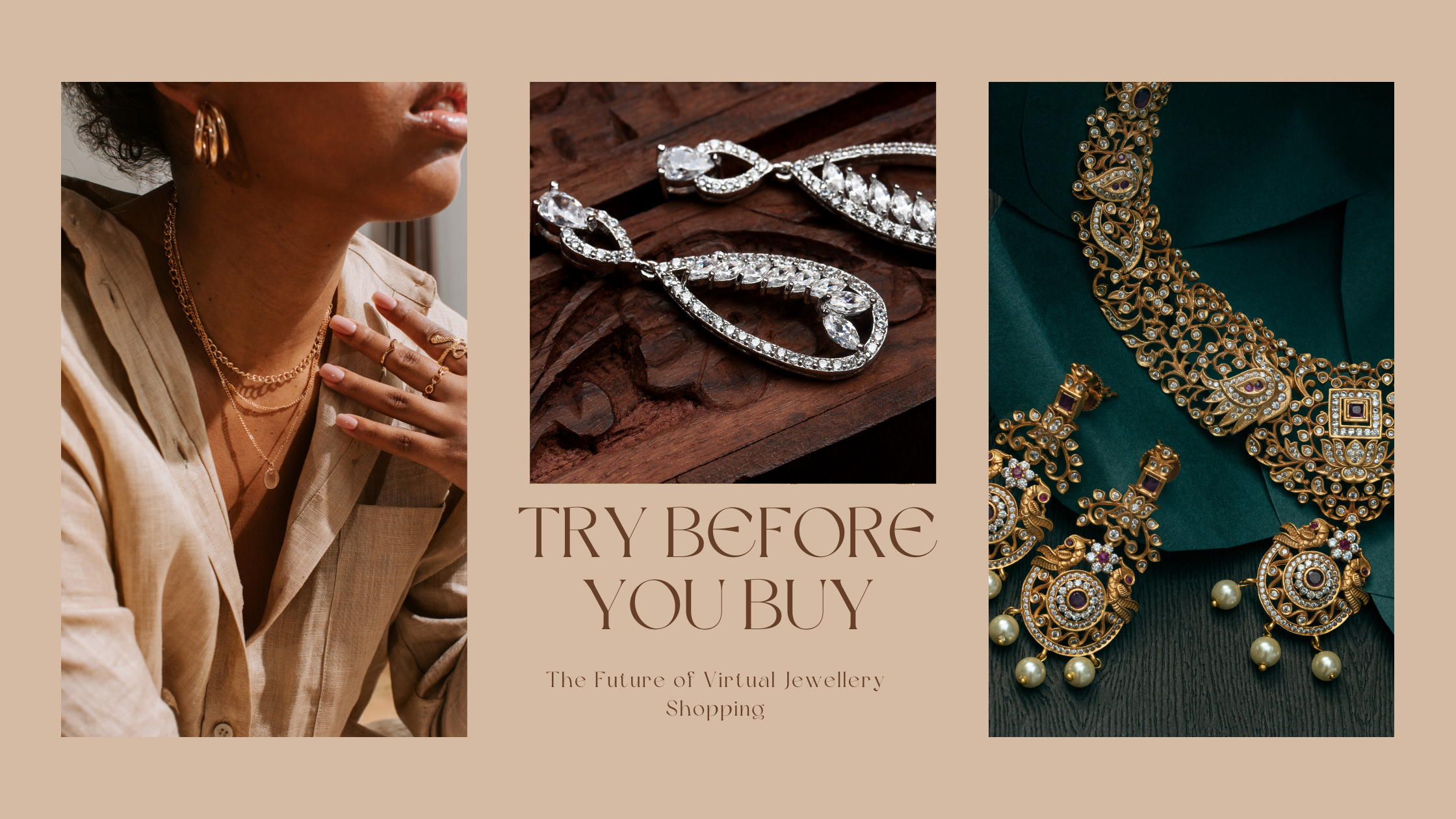

Try Before You Buy: The Future of Virtual Jewelry Shopping
Jewelry shopping has always been an affair filled with sparkle and a personal touch, evolving significantly over the years. From the intimate experience of visiting a brick-and-mortar store and examining the delicate craftsmanship of each piece to the rise of online catalogues and e-shops, the journey has been transformative. Now, with the emergence of virtual jewelry shopping technology, we stand at the cusp of a new era. This blog delves into how virtual try-on technology is changing and revolutionizing the jewelry shopping experience, making it more interactive, personalized, and convenient than ever before.
The Rise of E-Commerce in Jewelry Retail
The story of jewelry retail is as lustrous as the products it sells. Traditionally, purchasing jewelry was an experience that involved physical interaction with the products, often accompanied by expert guidance from a jeweller. However, with the advent of the digital age, there’s been a significant shift towards online shopping.
The transition opened up a world of convenience and variety for consumers, allowing them to browse endless collections with just a few clicks. Despite the ease, online jewelry shopping isn’t without its challenges. Customers often face difficulties in visualizing how a piece would look on them, leading to uncertainty and a high rate of returns. This gap between digital convenience and personal experience is where virtual try-on technology steps in, promising to bridge the divide.
Virtual Try-On Technology: An Overview
A. Definition and Explanation of Virtual Try-On Technology
Imagine stepping into a futuristic world where you can try on a necklace or a ring without physically touching it. That’s exactly what virtual try-on technology brings to the table. This nifty tool lets you see how a piece of jewelry looks on you through your digital device, blending the physical and digital realms. It’s a bit like having a magic mirror at your fingertips!
B. How it Works: Augmented Reality (AR) and 3D Modelling
Now, how does this technological wizardry happen? The secret sauce blends Augmented Reality (AR) and 3D modelling. Here’s a simple breakdown:
- Augmented Reality (AR): AR overlays digital images onto the real world. When you use a virtual try-on feature, AR technology projects the jewelry image onto your live camera feed. So, when you move your hand or turn your head, the piece of jewelry moves with you, just like it would in real life.
- 3D Modelling: This is what makes the jewelry look so realistic on your screen. Skilled artists create detailed 3D models of each piece, capturing every sparkle and shine. These models are then integrated into the AR system, ensuring that the jewellery not only fits perfectly onto your image but also reflects light and shadow just like the real thing.
C. Advantages over Traditional Online Shopping Methods
Virtual try-on technology is shaking up the world of online jewelry shopping in a big way. Here’s why:
- No Guesswork: Remember when you wished you could just see how that bracelet would look on your wrist before hitting ‘buy’? Virtual try-on eliminates the guesswork. You get a real-time preview, making it easier to decide.
- Convenience: You won’t need to visit multiple stores or try on dozens of pieces. With just a few clicks, you can explore a whole range of jewelry from the comfort of your couch.
- Personalization: Many virtual try-on tools let you play around with different styles, colours, and sizes. It’s like having a personal jeweller who instantly crafts pieces you like.
- Reduced Returns: A big headache with online shopping is the return process. With a more accurate sense of how the jewelry looks and feels, chances of dissatisfaction plummet, and so do the returns.
- Fun Factor: Let’s not forget it’s pretty fun to try on fancy jewelry virtually. It’s an engaging experience that often turns casual browsers into buyers.
In a nutshell, virtual try-on technology isn’t just a cool gimmick; it’s a game-changer in the world of online jewelry shopping, making the experience more realistic, convenient, and enjoyable.
Enhancing Customer Experience with Virtual Try-On
The advent of virtual try-on technology in the jewelry industry has marked a significant shift in how customers interact with products. This section explores how this technology enhances the customer experience, making jewellery shopping not just a task but an engaging and personal journey.
A. Interactive and Personalized Shopping Experience
Imagine stepping into a world where you can try on every piece of jewelry you fancy without leaving your home. That’s exactly what virtual try-on technology offers. It transforms the shopping experience from a passive scroll through images to an interactive, engaging activity. Customers can see how different pieces look on them, just as they would in a physical store, but with the added comfort and convenience of being anywhere they choose.
This personalized approach caters to individual tastes and preferences, making customers feel like the service is tailored just for them. It’s akin to having a personal jeweller in your pocket, ready to assist you at any moment.
B. Real-time Visualization and Customization Options
One of the most exciting features of virtual try-on technology is its ability to provide real-time visualization. Customers can see how a necklace, ring, or bracelet looks on them and adjust the position, size, and even style in real time. This immediate feedback is invaluable in helping customers make informed decisions.
C. Building Consumer Confidence and Reducing Return Rates
The leap from seeing a piece of jewelry online to actually purchasing it involves a great deal of trust from the customer. Virtual try-on technology bridges this trust gap significantly. By providing a realistic representation of how the jewellery will look and feel, it instills a higher level of confidence in the purchase decision. This confidence is not just comforting for the customer but also beneficial for retailers.
Challenges and Limitations
A. Technological Barriers and Limitations
- High Costs: Implementing advanced AR and 3D modelling technology can be expensive, making it a significant barrier for smaller retailers.
- Technical Requirements: Consumers need up-to-date hardware and software to effectively use virtual try-on features, which may not be accessible to everyone.
- Internet Dependency: A stable and high-speed internet connection is crucial for a seamless virtual try-on experience, limiting its use in areas with poor connectivity.
B. Accuracy and Realism of Virtual Try-On
- Size and Fit Issues: One of the biggest challenges is accurately depicting the size and fit of jewelry, as slight deviations can lead to dissatisfaction.
- Rendering Quality: Ensuring high-quality, realistic rendering of jewelry items is complex and requires sophisticated technology.
- Lighting and Reflections: Replicating how light interacts with different metals and gems is difficult, which can affect the visual appeal of the jewelry in the virtual environment.
C. Addressing Privacy and Security Concerns
- Data Privacy: With users uploading images and personal information, there’s a need for robust data privacy measures to protect consumer information.
- Image Misuse: Ensuring that images uploaded by users for virtual try-on are securely stored and not misused is a significant concern.
- Security Protocols: Retailers must invest in strong security protocols to prevent breaches, as any compromise could lead to a loss of consumer trust.
The Future of Virtual Jewelry Shopping
A. Emerging Trends and Future Developments
- Hyper-Realistic Experiences: Advancements in AR and VR will lead to more lifelike and immersive try-on experiences.
- Customization and Personalization: Future platforms will offer more personalized recommendations and custom design options based on user preferences.
- Sustainability Focus: Eco-conscious shopping will be facilitated by virtual try-ons, reducing the need for physical samples and lowering carbon footprint.
B. Integrating Virtual Try-On with Other Technologies
- AI-Enhanced Design Tools: AI will assist in creating unique designs and predicting trends, offering customers a tailored shopping experience.
- Machine Learning for Improved Accuracy: Machine learning algorithms will refine the fit and look of virtual jewelry, enhancing realism.
- Integration with Social Media: Seamless integration with social platforms for sharing designs and gathering feedback will become commonplace.
C. Predictions for Consumer Behavior and Market Dynamics
- Increased Online Purchases: As virtual try-ons become more reliable, consumers will feel more confident making online jewelry purchases.
- Shift in Retail Store Roles: Physical stores may evolve into showrooms for brand experience rather than primary sales points.
- Data-Driven Marketing Strategies: Retailers will utilize data from virtual try-ons for targeted marketing and improved customer service.
Conclusion
In conclusion, the advent of virtual try-on technology marks a significant leap forward for diamond jewellers in Kolkata and around the world. This innovative approach not only enhances the customer experience by providing a realistic and interactive way to shop for jewelry from the comfort of their home but also helps build trust and confidence in online purchases. The future of jewelry shopping looks more vibrant and accessible, promising a blend of tradition and technology for shoppers everywhere.


